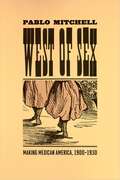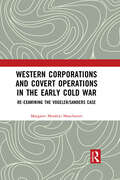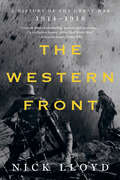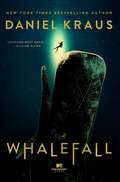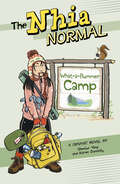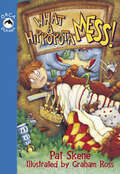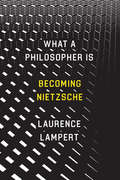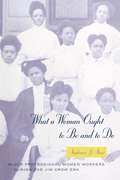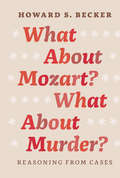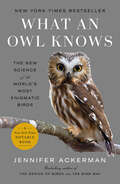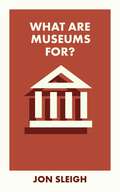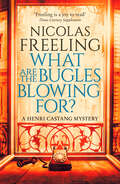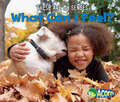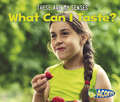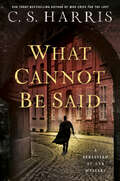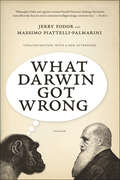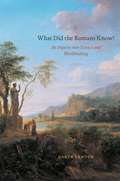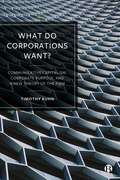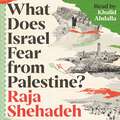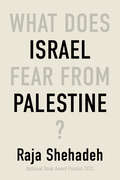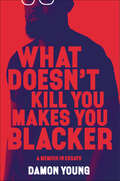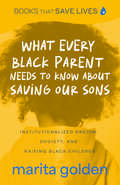- Table View
- List View
West of Sex: Making Mexican America, 1900–1930
by Pablo MitchellSex can be an oppressive force, a tool to shame, divide, and control a population. But it can also be a force for change, for the legal and physical challenge of inequity and injustice. In West of Sex, Pablo Mitchell uses court transcripts and criminal cases to provide the first coherent picture of Mexican-American sexuality at the turn of the twentieth century, and a truly revelatory look at sexual identity in the borderlands. As Mexicans faced a rising tide of racial intolerance in the American West, some found cracks in the legal system that enabled them to assert their rights as full citizens, despite institutional hostility. In these chapters, Mitchell offers a rare glimpse into the inner workings of ethnicity and power in the United States, placing ordinary Mexican women and men at the center of the story of American sex, colonialism, and belonging. Other chapters discuss topics like prostitution, same-sex intimacy, sexual violence, interracial romance, and marriage with an impressive level of detail and complexity. Written in vivid and accessible prose, West of Sex offers readers a new vision of sex and race in American history.
Western Corporations and Covert Operations in the early Cold War: Re-examining the Vogeler/Sanders Case
by Margaret Murányi ManchesterThis book examines the Vogeler/Sanders espionage case that ruptured ties between the US and UK and Hungary in 1949, and analyses this as an example of Western covert operations in the early Cold War. The work focuses on the 1949 case of ITT in Hungary, where two of its executives, the American Robert A. Vogeler and the Briton Edgar Sanders, were arrested by the secret police, tortured, forced to confess, put on a public show trial, and found guilty of espionage. This happened at a time that the US and the UK were cooperating in numerous operations to undermine the credibility of the communist regime and to encourage local resistance by “all means short of war.” Using the case as a lens to examine the dynamics of the early Cold War, the book integrates business history, diplomatic history and intelligence history, and thereby traces the impact of the case on Anglo-Hungarian, American-Hungarian, and Anglo-American relations during the critical period of 1949-1956. Vogeler’s case had a strong impact on the growing criticism of the Truman Administration’s containment policies and contributed to the demand for a more activist policy of ‘liberation of captive peoples’. His experiences also rallied the business community, especially trade associations such as the National Foreign Trade Council, the US Chamber of Commerce, and the National Association of Manufacturers, to support the anti-communist crusade both abroad and at home. Vogeler’s wife also waged a personal campaign to secure her husband’s release and exemplifies the activism of conservative and Catholic women who waged their own anti-communist crusade. The book thus tells the “rest of the story” often omitted in traditional works.This book will be of much interest to students of Cold War history, intelligence studies and European political history.
The Western Front: A History Of The Great War, 1914-1918
by Nick Lloyd“A tour de force of scholarship, analysis and narration.… Lloyd is well on the way to writing a definitive history of the First World War.” —Lawrence James, Times The Telegraph • Best Books of the Year The Times of London • Best Books of the Year A panoramic history of the savage combat on the Western Front between 1914 and 1918 that came to define modern warfare. The Western Front evokes images of mud-spattered men in waterlogged trenches, shielded from artillery blasts and machine-gun fire by a few feet of dirt. This iconic setting was the most critical arena of the Great War, a 400-mile combat zone stretching from Belgium to Switzerland where more than three million Allied and German soldiers struggled during four years of almost continuous combat. It has persisted in our collective memory as a tragic waste of human life and a symbol of the horrors of industrialized warfare. In this epic narrative history, the first volume in a groundbreaking trilogy on the Great War, acclaimed military historian Nick Lloyd captures the horrific fighting on the Western Front beginning with the surprise German invasion of Belgium in August 1914 and taking us to the Armistice of November 1918. Drawing on French, British, German, and American sources, Lloyd weaves a kaleidoscopic chronicle of the Marne, Passchendaele, the Meuse-Argonne, and other critical battles, which reverberated across Europe and the wider war. From the trenches where men as young as 17 suffered and died, to the headquarters behind the lines where Generals Haig, Joffre, Hindenburg, and Pershing developed their plans for battle, Lloyd gives us a view of the war both intimate and strategic, putting us amid the mud and smoke while at the same time depicting the larger stakes of every encounter. He shows us a dejected Kaiser Wilhelm II—soon to be eclipsed in power by his own generals—lamenting the botched Schlieffen Plan; French soldiers piling atop one another in the trenches of Verdun; British infantryman wandering through the frozen wilderness in the days after the Battle of the Somme; and General Erich Ludendorff pursuing a ruthless policy of total war, leading an eleventh-hour attack on Reims even as his men succumbed to the Spanish Flu. As Lloyd reveals, far from a site of attrition and stalemate, the Western Front was a simmering, dynamic “cauldron of war” defined by extraordinary scientific and tactical innovation. It was on the Western Front that the modern technologies—machine guns, mortars, grenades, and howitzers—were refined and developed into effective killing machines. It was on the Western Front that chemical warfare, in the form of poison gas, was first unleashed. And it was on the Western Front that tanks and aircraft were introduced, causing a dramatic shift away from nineteenth-century bayonet tactics toward modern combined arms, reinforced by heavy artillery, that forever changed the face of war. Brimming with vivid detail and insight, The Western Front is a work in the tradition of Barbara Tuchman and John Keegan, Rick Atkinson and Antony Beevor: an authoritative portrait of modern warfare and its far-reaching human and historical consequences.
We've Already Gone This Far: Stories
by Patrick DaceyA heartfelt, vital collection; the debut of an exciting new talent already hailed as one of George Saunders' "favorite young American writers"In Patrick Dacey's stunning debut, we meet longtime neighbors and friends--citizens of working-class Wequaquet--right when the ground beneath their feet has shifted in ways they don't yet understand. Here, after more than a decade of boom and bust, love and pride are closely twinned and dangerously deployed: a lonely woman attacks a memorial to a neighbor's veteran son; a dissatisfied housewife goes overboard with cosmetic surgery on national television; a young father walks away from one of the few jobs left in town, a soldier writes home to a mother who is becoming increasingly unhinged. We've Already Gone This Far takes us to a town like many towns in America, a place where people are searching for what is now an almost out-of-reach version of the American DreamStory by story, Dacey draws us into the secret lives of recognizable strangers and reminds us that life's strange intensity and occasional magic is all around us, especially in the everyday. With a skewering insight and real warmth of spirit, Dacey delivers that rare and wonderful thing in American fiction: a deeply-felt, deeply-imagined book about where we've been and how far we have to go.
Whalefall: A Novel
by Daniel KrausA USA TODAY BESTSELLER Named a Best Book of 2023 by Book Riot, Shelf Awareness, and NPR The Martian meets 127 Hours in this &“astoundingly great&” (Gillian Flynn, #1 New York Times bestselling author) and scientifically accurate thriller about a scuba diver who&’s been swallowed by an eighty-foot, sixty-ton sperm whale and has only one hour to escape before his oxygen runs out.Jay Gardiner has given himself a fool&’s errand—to find the remains of his deceased father in the Pacific Ocean off the coast of Monastery Beach. He knows it&’s a long shot, but Jay feels it&’s the only way for him to lift the weight of guilt he has carried since his dad&’s death by suicide the previous year. The dive begins well enough, but the sudden appearance of a giant squid puts Jay in very real jeopardy, made infinitely worse by the arrival of a sperm whale looking to feed. Suddenly, Jay is caught in the squid&’s tentacles and drawn into the whale&’s mouth where he is pulled into the first of its four stomachs. He quickly realizes he has only one hour before his oxygen tanks run out—one hour to defeat his demons and escape the belly of a whale. Suspenseful and cinematic, Whalefall is an &“powerfully humane&” (Owen King, New York Times bestselling author) thriller about a young man who has given up on life…only to find a reason to live in the most dangerous and unlikely of places.
What-a-Bummer Camp (The\nhia Normal Ser.)
by Sheelue Yang"Eleven-year-old Nhia is nervous about summer camp in this installment of The Niah Normal graphic novel series. Eleven-year-old Nhia “Silver” Lee is headed to summer camp. Unfortunately, she’s packing her nerves along for the trip. Can she build a fire? Will she be able to fall asleep in a tent? And what if the other campers don’t like her? This Hmong American girl will need to overcome her own self-doubt to make summer camp less of a total bummer. Written by Sheelue Yang, this graphic novel is a darkly humorous, normalizing exploration of coming-of-age anxiety through the lens of an authentic preteen girl. More Books in This Series: Losing It in Translation School of (Negative) Thought Talent Show of Nerves"
What a Hippopota-Mess! (Orca Echoes)
by Pat Lamondin SkeneThe poems in this book tell stories of animals and nature. From two sweaty hippos, a smiling lizard and some creepy crawlers to a few tricky dandelions. At the end of each poem, find out more in an interview with a key character or a list of fascinating facts. The epub edition of this title is fully accessible.
What a Philosopher Is: Becoming Nietzsche
by Laurence LampertThe trajectory of Friedrich Nietzsche’s thought has long presented a difficulty for the study of his philosophy. How did the young Nietzsche—classicist and ardent advocate of Wagner’s cultural renewal—become the philosopher of Will to Power and the Eternal Return? With this book, Laurence Lampert answers that question. He does so through his trademark technique of close readings of key works in Nietzsche’s journey to philosophy: The Birth of Tragedy, Schopenhauer as Educator, Richard Wagner in Bayreuth, Human All Too Human, and “Sanctus Januarius,” the final book of the 1882 Gay Science. Relying partly on how Nietzsche himself characterized his books in his many autobiographical guides to the trajectory of his thought, Lampert sets each in the context of Nietzsche’s writings as a whole, and looks at how they individually treat the question of what a philosopher is. Indispensable to his conclusions are the workbooks in which Nietzsche first recorded his advances, especially the 1881 workbook which shows him gradually gaining insights into the two foundations of his mature thinking. The result is the most complete picture we’ve had yet of the philosopher’s development, one that gives us a Promethean Nietzsche, gaining knowledge even as he was expanding his thought to create new worlds.
What a Woman Ought to Be and to Do: Black Professional Women Workers during the Jim Crow Era (Women In Culture And Society Ser.)
by Stephanie J. ShawStephanie J. Shaw takes us into the inner world of American black professional women during the Jim Crow era. This is a story of struggle and empowerment, of the strength of a group of women who worked against daunting odds to improve the world for themselves and their people. Shaw's remarkable research into the lives of social workers, librarians, nurses, and teachers from the 1870s through the 1950s allows us to hear these women's voices for the first time. The women tell us, in their own words, about their families, their values, their expectations. We learn of the forces and factors that made them exceptional, and of the choices and commitments that made them leaders in their communities.What a Woman Ought to Be and to Do brings to life a world in which African-American families, communities, and schools worked to encourage the self-confidence, individual initiative, and social responsibility of girls. Shaw shows us how, in a society that denied black women full professional status, these girls embraced and in turn defined an ideal of "socially responsible individualism" that balanced private and public sphere responsibilities. A collective portrait of character shaped in the toughest circumstances, this book is more than a study of the socialization of these women as children and the organization of their work as adults. It is also a study of leadership—of how African American communities gave their daughters the power to succeed in and change a hostile world.
What a Woman Wants: Contains The Playa's Handbook, No More Playas, What A Woman Wants (Playas Series #3)
by Brenda JacksonAfter a close friend commits suicide, Faith, Monique, and Shannon head to the beach cottage on Hilton Head Island. Determined to heed her advice and make the most of their lives, they make a pact to spend the summer embracing new adventures. They also embrace new men and a new best friend along the way.Filled with profound passion and sensuality, witty dialogue and richly drawn characters, this is a story of women having fun, embracing life, taking charge, and doing the things they want –and discovering in the process that everyone deserves to kick the routine every once in a while, let their hair down and explore new things. And if the right man comes along, especially one who is willing to make an already hot summer even hotter, then pushing the envelope just might give her life the jolt it needs.
What About Mozart? What About Murder?: Reasoning From Cases
by Howard S. BeckerIn 1963, Howard S. Becker gave a lecture about deviance, challenging the then-conventional definition that deviance was inherently criminal and abnormal and arguing that instead, deviance was better understood as a function of labeling. At the end of his lecture, a distinguished colleague standing at the back of the room, puffing a cigar, looked at Becker quizzically and asked, “What about murder? Isn’t that really deviant?” It sounded like Becker had been backed into a corner. Becker, however, wasn’t defeated! Reasonable people, he countered, differ over whether certain killings are murder or justified homicide, and these differences vary depending on what kinds of people did the killing. In What About Mozart? What About Murder?, Becker uses this example, along with many others, to demonstrate the different ways to study society, one that uses carefully investigated, specific cases and another that relies on speculation and on what he calls “killer questions,” aimed at taking down an opponent by citing invented cases. Becker draws on a lifetime of sociological research and wisdom to show, in helpful detail, how to use a variety of kinds of cases to build sociological knowledge. With his trademark conversational flair and informal, personal perspective Becker provides a guide that researchers can use to produce general sociological knowledge through case studies. He champions research that has enough data to go beyond guesswork and urges researchers to avoid what he calls “skeleton cases,” which use fictional stories that pose as scientific evidence. Using his long career as a backdrop, Becker delivers a winning book that will surely change the way scholars in many fields approach their research.
What an Owl Knows: The New Science of the World's Most Enigmatic Birds
by Jennifer AckermanAn instant New York Times bestseller!A New York Times Notable Book of 2023Named a Best Book of 2023 by Publishers WeeklyFrom the author of The Genius of Birds and The Bird Way, a brilliant scientific investigation into owls—the most elusive of birds—and why they exert such a hold on human imaginationWith their forward gaze and quiet flight, owls are often a symbol of wisdom, knowledge, and foresight. But what does an owl really know? And what do we really know about owls? Some two hundred sixty species of owls exist today, and they reside on every continent except Antarctica, but they are far more difficult to find and study than other birds because they are cryptic, camouflaged, and mostly active at night. Though human fascination with owls goes back centuries, scientists have only recently begun to understand the complex nature of these extraordinary birds. In What an Owl Knows, Jennifer Ackerman joins scientists in the field and explores how researchers are using modern technology and tools to learn how owls communicate, hunt, court, mate, raise their young, and move about from season to season. Ackerman brings this research alive with her own personal field observations; the result is an awe-inspiring exploration of owls across the globe and through human history, and a spellbinding account of the world&’s most enigmatic group of birds.
What Are Museums For? (What Is It For?)
by Jon SleighThe days when museums were dusty, stuffy institutions displaying their wealth and wisdom to a reverential public are over. Museums today are a cultural battleground. Who should decide what is put on display and how it is presented? Who gets to set the narrative? In this passionately argued book, Jon Sleigh maintains that museums must be for all people and inclusion must be at the heart of everything they do. But what does good inclusion look like in practice? Cleverly structured like a museum tour, Sleigh uses seven illustrative museum objects from seven very different museums to explore such wide-ranging issues as trust-building, representation, digital access, conflicting narratives, removal from display and restitution.
What Are the Bugles Blowing For? (The Henri Castang Mysteries)
by Nicolas FreelingFrom an Edgar Award–winning British crime novelist, this unsettling homicide investigation features the unorthodox French detective Henri Castang.On a sultry summer night in a French provincial city, Insp. Henri Castang is summoned from his office at the Police Judiciaire to the site of a triple murder. The killer? A husband who came home unexpectedly to discover his wife and daughter in bed with another man. A crime of passion? Perhaps. Except the murderer in question, wealthy financier Gilbert La Touche, is cool and remote. His confession is as factual and bloodless as the crime is violent and deeply disturbing. As a detective, Castang must play by the rules to protect himself. But for an unconventional cop like Castang, that is virtually impossible. After all, there’s more to murder than a few corpses and a killer, and Castang will follow every twist until he gets to the heart of the evil at hand.Praise for Nicolas Freeling“Nicolas Freeling . . . liberated the detective story from page-turning puzzler into a critique of society and an investigation of character.” —The Daily Telegraph“Freeling rewards with his oblique, subtly comic style.” —Publishers Weekly
What Can I Feel? (These Are My Senses Ser.)
by Joanna IssaThis book takes a very simple look at children's sense of touch. Leveled text with repeated use of high frequency words makes the book perfect for beginning readers, while bright, colorful photographs complement the text and maintain readers' interest.
What Can I Taste? (These Are My Senses Ser.)
by Joanna IssaThis book takes a very simple look at children's sense of taste. Leveled text with repeated use of high frequency words makes the book perfect for beginning readers, while bright, colorful photographs complement the text and maintain readers' interest.
What Can You See in Summer? (Seasons Ser.)
by Sian SmithBooks in this series introduce emergent readers to the four seasons. In Summer, children are taken on a tour of things they can see in summer including typical summer activities and changes in the natural world. Beautiful photos, very simple repeated text, high frequency and decodeable words and strong photo-to-text matching make this a perfect book for early readers to enjoy.
What Cannot Be Said (Sebastian St. Cyr Mystery #19)
by C. S. HarrisA seemingly idyllic summer picnic ends in a macabre murder that echoes a pair of slayings fourteen years earlier in this riveting new historical mystery from the USA Today bestselling author of Who Cries for the Lost.July 1815: The Prince Regent&’s grandiose plans to celebrate Napoléon&’s recent defeat at Waterloo are thrown into turmoil when Lady McInnis and her daughter Emma are found brutally murdered in Richmond Park, their bodies posed in a chilling imitation of the stone effigies once found atop medieval tombs. Bow Street magistrate Sir Henry Lovejoy immediately turns to his friend Sebastian St. Cyr, Viscount Devlin, for help with the investigation. For as Devlin discovers, Lovejoy&’s own wife and daughter were also murdered in Richmond Park, their bodies posed in the same bizarre postures. A traumatized ex-soldier was hanged for their killings. So is London now confronting a malicious copyist? Or did Lovejoy help send an innocent man to the gallows?Aided by his wife, Hero, who knew Lady McInnis from her work with poor orphans, Devlin finds himself exploring a host of unsavory characters from a vicious chimney sweep to a smiling but decidedly lethal baby farmer. Also coming under increasing scrutiny is Sir Ivo McInnis himself, along with a wounded Waterloo veteran—who may or may not have been Laura McInnis&’s lover—and a charismatic young violinist who moonlights as a fencing master and may have formed a dangerous relationship with Emma. But when Sebastian&’s investigation turns toward man about town Basil Rhodes, he quickly draws the fury of the Palace, for Rhodes is well known as the Regent&’s favorite illegitimate son.Then Lady McInnis&’s young niece and nephew are targeted by the killer, and two more women are discovered murdered and arranged in similar postures. With his own life increasingly in danger, Sebastian finds himself drawn inexorably toward a conclusion far darker and more horrific than anything he could have imagined.
What Darwin Got Wrong
by Jerry Fodor Massimo Piattelli-PalmariniWhat Darwin Got Wrong is a remarkable book, one that dares to challenge the theory of natural selection as an explanation for how evolution works---a devastating critique not in the name of religion but in the name of good science. Combining the results of cutting-edge work in experimental biology with crystal-clear philosophical arguments, Fodor and Piattelli-Palmarini mount a reasoned and convincing assault on the central tenets of Darwin's account of the origin of species. This is a concise argument that will transform the debate about evolution and move us beyond the false dilemma of being either for natural selectionor against science.
What Did the Romans Know?: An Inquiry into Science and Worldmaking
by Daryn LehouxWhat did the Romans know about their world? Quite a lot, as Daryn Lehoux makes clear in this fascinating and much-needed contribution to the history and philosophy of ancient science. Lehoux contends that even though many of the Romans’ views about the natural world have no place in modern science—the umbrella-footed monsters and dog-headed people that roamed the earth and the stars that foretold human destinies—their claims turn out not to be so radically different from our own. Lehoux draws upon a wide range of sources from what is unquestionably the most prolific period of ancient science, from the first century BC to the second century AD. He begins with Cicero’s theologico-philosophical trilogy On the Nature of the Gods, On Divination, and On Fate, illustrating how Cicero’s engagement with nature is closely related to his concerns in politics, religion, and law. Lehoux then guides readers through highly technical works by Galen and Ptolemy, as well as the more philosophically oriented physics and cosmologies of Lucretius, Plutarch, and Seneca, all the while exploring the complex interrelationships between the objects of scientific inquiry and the norms, processes, and structures of that inquiry. This includes not only the tools and methods the Romans used to investigate nature, but also the Romans’ cultural, intellectual, political, and religious perspectives. Lehoux concludes by sketching a methodology that uses the historical material he has carefully explained to directly engage the philosophical questions of incommensurability, realism, and relativism. By situating Roman arguments about the natural world in their larger philosophical, political, and rhetorical contexts, What Did the Romans Know? demonstrates that the Romans had sophisticated and novel approaches to nature, approaches that were empirically rigorous, philosophically rich, and epistemologically complex.
What Do Corporations Want?: Communicative Capitalism, Corporate Purpose, and a New Theory of the Firm
by Timothy Kuhn'Corporate purpose' has become a battleground for stakeholders’ competing desires. Some argue that corporations must simply generate profit; others suggest that we must make them create social change.Leading organization studies scholar Timothy Kuhn argues that this 'either/or' thinking dramatically oversimplifies matters: today’s corporations must be many things, all at once.Kuhn offers a bold new Communicative Theory of the Firm to highlight the authority that creates corporations’ identities and activities. The theory provides a roadmap for navigating that battleground of competing desires to produce more responsive corporations.Drawing on communicative and new materialist theorizing, along with three insightful case studies, this book thoroughly redefines our understandings of what corporations are 'for'.
What Does Israel Fear from Palestine?
by Raja ShehadehWhen the state of Israel was formed in 1948, it precipitated the Nakba or 'disaster': the displacement of the Palestine nation, creating fracture-lines which continue to erupt in violent and tragic ways today.In the years that followed, while the Berlin Wall crumbled and South Africa abolished apartheid, the Israeli government rejected every opportunity for reconciliation with Palestine. But Raja Shehadeh, human rights lawyer and Palestine's greatest living writer, suggests that this does not mean the two nations cannot work together aspartners on the road to peace, not genocide.In graceful, devastatingly observed prose, this is a fresh perspective for a time of great need.Medical Aid for Palestinians (MAP) is a registered charity in the UK with charity no. 1045315.A portion of the proceeds* received by Profile Books from this audiobook will be given to the charity for their work for the health and dignity of Palestinians living under occupation and as refugees. This donation has been made possible by the author Raja Shehadeh, Refaat Alareer, Khalid Abdalla and Profile Books.*Proceeds means the cash-price or cash-equivalent price less sales taxes.
What Does Israel Fear From Palestine?
by Raja ShehadehA poignant, incisive meditation on Israel&’s longstanding rejection of peace, and what the war on Gaza means for Palestinian and Israeli futures.When apartheid in South Africa ended in 1994, dismantled by internal activism and global pressure, why did Israel continue to pursue its own apartheid policies against Palestinians? In keeping with a history of antagonism, the Israeli state accelerated the establishment of settlements in the Occupied Territories as extreme right-wing voices gained prominence in government, with comparatively little international backlash.Condensing this complex history into a lucid essay, Raja Shehadeh examines the many lost opportunities to promote a lasting peace and equality between Israelis and Palestinians. Since the creation of Israel in 1948, known to Palestinians as the Nakba, or catastrophe, each side&’s perception of events has strongly diverged. What can this discrepancy tell us about Israel&’s undermining of a two-state solution? And will the current genocide in Gaza finally mark a shift in the world&’s response? With graceful, haunting prose, Shehadeh offers insights into a defining conflict that could yet be resolved.
What Doesn't Kill You Makes You Blacker: A Memoir in Essays
by Damon YoungA Finalist for the NAACP Image AwardA Finalist for the Hurston/Wright Legacy Award for NonfictionA Finalist for the Thurber Prize for American HumorLonglisted for the PEN/Diamonstein-Spielvogel Award for the Art of the EssayAn NPR Best Book of the YearA Washington Independent Review of Books Favorite of the YearFrom the host of podcast "Stuck with Damon Young," cofounder of VerySmartBrothas.com, and one of the most read writers on race and culture at work today, a provocative and humorous memoir-in-essays that explores the ever-shifting definitions of what it means to be Black (and male) in AmericaFor Damon Young, existing while Black is an extreme sport. The act of possessing black skin while searching for space to breathe in Americais enough to induce a ceaseless state of angst where questions such as “How should I react here, as a professional black person?” and “Will this white person’s potato salad kill me?” are forever relevant.What Doesn’t Kill You Makes You Blacker chronicles Young’s efforts to survive while battling and making sense of the various neuroses his country has given him.It’s a condition that’s sometimes stretched to absurd limits, provoking the angst that made him question if he was any good at the “being straight” thing, as if his sexual orientation was something he could practice and get better at, like a crossover dribble move or knitting; creating the farce where, as a teen, he wished for a white person to call him a racial slur just so he could fight him and have a great story about it; and generating the surreality of watching gentrification transform his Pittsburgh neighborhood from predominantly Black to “Portlandia . . . but with Pierogies.” And, at its most devastating, it provides him reason to believe that his mother would be alive today if she were white.From one of our most respected cultural observers, What Doesn’t Kill You Makes You Blacker is a hilarious and honest debut that is both a celebration of the idiosyncrasies and distinctions of Blackness and a critique of white supremacy and how we define masculinity.
What Every Black Parent Needs to Know About Saving Our Sons: Institutionalized Racism, Society, and Raising Black Children (Books That Save Lives)
by Marita GoldenEmpower Your Sons Against Institutionalized Racism“One of the most important pieces of literature for Black parents.”—MJ Fievre, author of Raising Confident Black KidsA powerful guide to navigate the challenges of raising families in turbulent times. In What Every Black Parent Needs to Know about Saving Our Sons, gain profound advice on how to protect and nurture Black teen boys.Essential knowledge, practical guidance. With intimate storytelling of her own son’s story and in-depth research against the chilling backdrop of racially motivated brutality, acclaimed author Marita Golden reveals alarming statistics and systemic issues affecting children of color—and remedies.A powerful and timely resource, What Every Black Parent Needs to Know about Saving Our Sons addresses pressing issues of today with new material and updated resources. Wisdom from psychologists, writers, and young Black men initiates meaningful discussions and delves into the complexities of Black parenting. Tackle topics such as generational trauma, being Black in white spaces, institutionalized racism, gun violence and how to not get shot, supporting mental health for black men, and other problems Black kids face. Embark on a transformative journey towards raising confident, successful, and resilient kids.Inside, find:Realities faced by Black families and the importance of teaching kids about racismGuidance to navigate, discuss, and explore the impact of fearing the black bodyConversations and strategies to keep our kids safe and growing up greatIf you liked The Light We Carry, Decoding Boys, Three Mothers, or American Carnage, you’ll love What Every Black Parent Needs to Know about Saving Our Sons.
